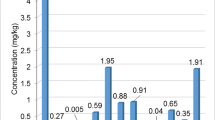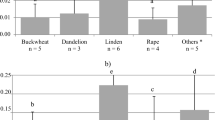Abstract
Lead concentrations were analysed by atomic absorption spectrometry in multifloral honeys collected in central Croatia (Zagreb County) during a three-year period from 2009 to 2011. The mean levels of elements (μg/kg) in honey samples measured were: 90.8 in 2009, 189 in 2010 and 360 in 2011. Significant differences were observed, and Pb levels determined in 2009 were significantly lower than those in 2010 and 2011 (p < 0.05, both). In 2009 there was no concentration found above 300 μg/kg. However, in 2010 and 2011 levels exceeding 300 μg/kg were found in 28.6 % and 25 % of samples. Trace element levels of Pb determined in multifloral honey were generally higher than concentrations obtained from other geographical origins and neighbouring countries. These high concentrations of Pb may be related to the fact that the central region is becoming increasingly urban and the network of motorways is growing. Accordingly, the risk of positioning hives near zones of busy highways and railways is increasing. This underlines that particular attention should be paid to toxic Pb levels, due to their gradual increased during the study period.

Similar content being viewed by others
References
Ajtony Z, Bencs L, Haraszi R, Szigeti J, Szoboszlai N (2007) Study on the simultaneous determination of some essential and toxic trace elements in honey by multi-element graphite furnace atomic absorption spectrometry. Talanta 71:683–690
Anklam E (1998) A review of the analytical methods to determine the geographical and botanical origin of honey. Food Chem 63:549–562
Antonescu C, Mateescu C (2001) Environmental pollution and its effects on honey quality. Roman Biotech Lett 6:371–379
Bilandžić N, Đokić M, Sedak M, Kolanović BS, Varenina I, Končurat A, Rudan N (2011) Determination of trace elements in Croatian floral honey originating from different regions. Food Chem 128:1160–1164
Bogdanov S, Haldimann M, Luginbühl W, Gallmann P (2007) Minerals in honey: environmental, geographical and botanical aspects. J Apicul Res 46:269–275
Bratu I, Georgescu C (2005) Chemical contamination of bee honey—identifying sensor of the environment pollution. J Cent Eur Agric 6(1):467–470
Buldini PL, Cavalli S, Mevoli A, Sharma JL (2001) Ion chromatographic and voltametric determination of heavy and transition metals in honey. Food Chem 73:487–495
Conti ME, Botre F (2001) Honeybees and their products as potential bioindicators of heavy metals contamination. Environ Monit Assess 69:267–282
Golob T, Doberšek U, Kump P, Nečemer M (2005) Determination of trace and minor elements in Slovenian honey by total reflection X-ray fluorescence spectroscopy. Food Chem 91:593–600
Johnson FM (1998) The genetic effects of environmental lead. Mutat Res 410:123–140
Pisani A, Protano G, Riccobono F (2008) Minor and trace elements in different honey types produced in Siena County (Italy). Food Chem 107:1553–1560
Przybyłowski P, Wilczyńska A (2001) Honey as an environmental marker. Food Chem 74:289–291
Rashed MN, Soltan ME (2004) Major and trace elements in different types of Egyptian mono-floral and non-floral bee honeys. J Food Comp Anal 17:725–735
Silici S, Uluozlu OD, Tuzen M, Soylak M (2008) Assessment of trace element levels in rhododendron honeys of Black sea Region, Turkey. J Hazard Mater 156:612–618
Swarup D, Patra RC, Naresh R, Kumar P, Shekhar P (2005) Blood lead levels in lactating cows reared around polluted localities; transfer of lead into milk. Sci Total Environ 347:106–110
Toporcák J, Legáth J, Kul’ková J (1992) Levels of mercury in samples of bees and honey from areas with and without industrial contamination. Vet Med 37:405–412
Tuzen M, Soylak M (2005) Heavy metal levels in microwave digested honey samples from middle Anatolia, Turkey. J Food Drug Anal 3:343–347
Tuzen M, Silici S, Mendil D, Soylak M (2007) Trace element levels in honeys from different regions of Turkey. Food Chem 103:325–330
Vanhanen LP, Emmertz A, Savage GP (2011) Mineral analysis of mono-floral New Zealand honey. Food Chem 128:236–240
Vorlová L, Čelechovská O (2002) Activity of enzymes and trace element content in bee honey. Acta Vet Brno 71:375–378
WHO (2000) Evaluation of certain food additives and contaminants. Fifty-third Report of the Joint FAO/WHO Expert Committee on Food Additives. Technical Report Series 896. Geneva, Switzerland
Acknowledgments
We thank Marijana Fluka and Mirjana Hren for assistance in sample preparation. This study was supported with a grant from the Croatian Veterinary Institute, Zagreb, Croatia.
Author information
Authors and Affiliations
Corresponding author
Rights and permissions
About this article
Cite this article
Bilandžić, N., Sedak, M., Đokić, M. et al. Lead Content in Multifloral Honey from Central Croatia over a Three-Year Period. Bull Environ Contam Toxicol 88, 985–989 (2012). https://doi.org/10.1007/s00128-012-0585-z
Received:
Accepted:
Published:
Issue Date:
DOI: https://doi.org/10.1007/s00128-012-0585-z




